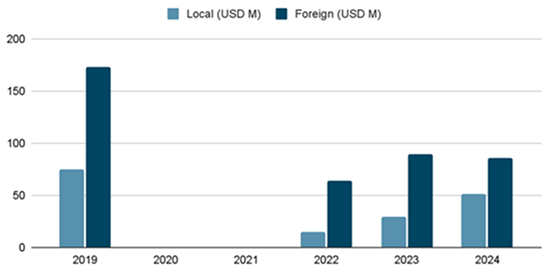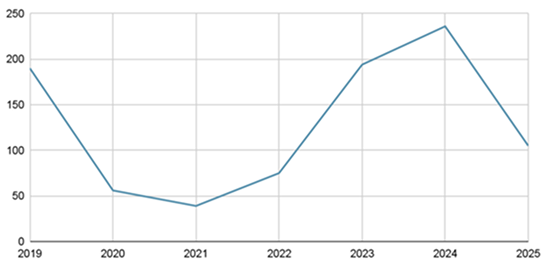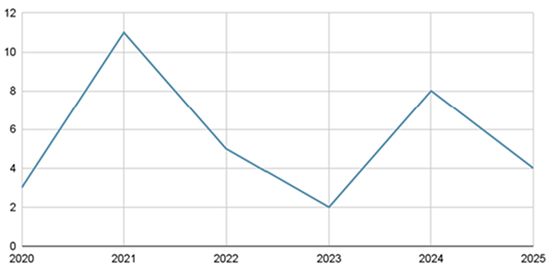Title

 Dodo DAYAO
Writer, Director, Producer
Dodo DAYAO
Writer, Director, Producer
 Patti LAPUS
Producer, Intimacy Coordinator
Patti LAPUS
Producer, Intimacy Coordinator
Overview
The year 2025 marked the second year of the Eddie Garcia Law (EGL) as an operative statute. Named after veteran actor Eddie Garcia, who died following an on-set accident in 2019, the law represents the first comprehensive regulation of working hours across the Philippine entertainment sector. Its passage has been widely described as a watershed moment, reshaping production practices in film, television, and advertising. Yet its economic and cultural ramifications remain under negotiation, with stakeholders acknowledging both its necessity for worker protection and its unintended consequences for production viability.
The broader economic trajectory of Philippine cinema underscores these challenges. Box office revenues have yet to return to pre-pandemic levels, with the industry grossing $0.24B in 2019 before collapsing in 2020–2021. A slow recovery began in 2022 ($0.08B) and strengthened in 2023 ($0.12B) and 2024 ($0.14B), though still far below pre-pandemic benchmarks. The 2025 data remains incomplete at midyear, but early indicators suggest continued volatility, with contraction in film releases partly offset by breakout successes.
This report examines the Philippine film industry in 2025 in relation to the EGL, analyzing its effects on production volume, industrial structures, genre trends, controversies, and festival circuits. It draws on available data from the Film Development Council of the Philippines (FDCP), critical studies such as John Tawasil’s survey for the Society of Filipino Film Reviewers (SFFR), and observed release patterns across theatrical and streaming platforms. The analysis suggests that while 2025 has been marked by contraction in film output, the industry continues to exhibit resilience through new voices, festival frameworks, and films that achieve both cultural relevance and commercial traction.
Local and Foreing Boxoffice (2019-2024)


Production Landscape
Data from the FDCP and the SFFR both point to a contraction in film output. FDCP reported that the number of films submitted to the Movie and Television Review and Classification Board (MTRCB) dropped from 236 in 2024 to 105 in 2025.
Total Number of Local Films (2019-2025, as of July 24, 2025)


Source: Film Development Council of the Philippines
While direct causation cannot be empirically proven, the correlation with the Eddie Garcia Law (EGL) is difficult to ignore. Shortened working hours, combined with rising production budgets and the persistent decline of cinema attendance, have made film financing riskier.
Despite this downturn, several structural supports have kept the production landscape alive. Festivals such as Cinepanalo, Cinemalaya, QCinema, and the Metro Manila Film Festival (MMFF) continue to anchor the industry calendar. Cinepanalo, in particular, has grown in importance, with its second edition in March 2025 drawing both emerging and established filmmakers, including JP Habac and Mes de Guzman. Its grant-based model made March the “most prolific release month” of the year (SFFR, 2025).
According to the survey of Society of Filipino Film Reviewers (Courtesy of John Tawasil), the current state of the film industry in H1 2025 in the Philippines is as follows:
- Compared to the same time period in 2024, there was a 19% decrease in the number of new releases (71 films as opposed to 87 releases in 2024.
- Theatrical releases (including film fest entries) saw a 15% decrease from last year.
- Vivamax/VMX seems to have scaled down their production, with a 27.5% decrease compared to 2024. Notably, VMX seems to have stopped producing films of under 60 minites in length, opting instead to produce slightly longer films of 60-75 minutes in length. It is unclear if looming issues with the expansion of MTRCB reach has affected production as well.
- On average, around 11-12 Filipino films were released per month in the first half of the year, either on streaming or as a theatrical release with a rought 50-50 split.
- Most films during this time period were released in March (20 films), partly due to the Puregold Cinepanalo Film Festival.
- Even without Cinepanalo, March would still be the most prolific release month in 2025 (13 films)
Genre patterns reveal continuity amid contraction. Erotica, horror, and romance remain dominant, though even major players like VMX (Vivamax) reduced output by 27.5%. Horror has retained its commercial reliability, while romance—long a mainstay of Philippine cinema—has grown less predictable. Irene Villamor’s Only We Know typified these challenges, winning praise yet hampered by abrupt regulatory reclassification.
The industry continues to balance established names with new voices. Antoinette Jadaone’s Sunshine marked a daring shift from romantic comedy to socially charged drama, while King Palisoc’s Song of the Fireflies illustrated how international festival exposure can amplify local prestige.
 Behind-the-scenes photo from Sunshine. Courtesy of Antoinette Jadaone.
Behind-the-scenes photo from Sunshine. Courtesy of Antoinette Jadaone.
Financing Models
The financing climate in 2025 reflects both caution and creativity. Rising costs linked to EGL implementation, coupled with shrinking theatrical attendance, have made investors wary.
Film financing has therefore leaned heavily on festival-backed grants and brand sponsorships. Cinepanalo, funded by retail giant Puregold, has emerged as a vital soft-money source, enabling filmmakers to produce diverse titles across genres. Cinemalaya continues to nurture emerging filmmakers with festival-to-festival circulation in mind.
International circuits have become indispensable for Philippine films in 2025, particularly independent filmmakers, with projects like Song of the Fireflies and Sunshine, which won the Crystal Bear for Best Film in the Generation 14plus section at the Berlin International Film Festival, leveraging global festival circuits to attract attention and eventual domestic distribution while distribution. Meanwhile, Baby Ruth Villarama's documentary on the West Philippine Sea, Food Delivery similarly turned geopolitical controversy into international momentum, transforming the documentary into a cultural diplomacy case study.
Private equity investment in film remains limited, with television and streaming absorbing most risk capital. Traditional studio financing has contracted, as the commercial profitability of mainstream genres has grown uncertain. Nonetheless, the system is adapting: while hard-money flows are conservative, soft-money interventions from festivals, government-linked grants, and sponsorships remain crucial lifelines for sustaining production.
 Scene from Song of the Fireflies. Courtesy of King Palisoc.
Scene from Song of the Fireflies. Courtesy of King Palisoc.
Distribution Climate
Distribution in 2025 has been marked by continued Hollywood dominance, tempered by festival-driven surges for domestic titles. Theatrical pipelines remain fragile, with major distributors relying heavily on foreign tentpoles to sustain box office volume. Streaming platforms, meanwhile, have emerged as parallel distributors, particularly for independent films and regional releases.
According to Vitrina.ai (2024), the top five distributors in the Philippines were:
Top 5 Distributors in 2024
- Viva International Pictures / MVP Entertainment – known for distributing both Hollywood and Asian titles, including local Viva productions.
- Columbia Pictures Philippines (Sony Pictures Releasing) – anchored by tentpoles such as Spider-Man: Across the Spider-Verse.
- Warner Bros. Philippines – boosted by Barbie and Aquaman 2.
- Disney Philippines – sustained by Marvel and Disney Animation releases.
- Universal Pictures International (UIP Philippines) – responsible for Fast X, Oppenheimer, and other global franchise releases.
- Note: As of mid-2025, no verified distributor market data has been released. The 2024 data remain the most recent reference point.
These companies collectively dominated the 2024 theatrical market, underscoring Philippine exhibition’s dependence on Hollywood distribution pipelines. Independent and local distributors comprised only a small share, with exceptions occurring when festival-backed titles broke through.
At the same time, streaming platforms function as parallel distributors, reshaping access and recoupment. Netflix and Disney+ now handle direct-to-digital releases in the Philippines, while iWantTFC distributes Kapamilya originals both locally and abroad. Amazon Prime Video, Viu, and Max likewise serve as digital pipelines for Asian dramas and international content. For independent and festival films, streaming deals increasingly serve as primary or secondary windows, compensating for limited theatrical exposure.
According to John Tawasil of SFFR, the majority of Filipino films in 2024 were released via streaming services, among which a significant portion were from Vivamax/VMX (29 films). The rest were released via other streaming services such as Netflix, Bisayaflix, IWantTFC PPV. And the rest of Filipino releases were via theaters, either as normal theatrical releases or as part of a film festival (total 35 films).
By 2025, this dual system—Hollywood-led theatrical distribution alongside streaming-led digital distribution—has defined the Philippine market. Yet titles like Sunshine and Food Delivery show that local distributors, often working through festivals, can still carve out visibility despite structural imbalances.
Film Distribution Breakdown (2024)
| Statistics | Alt Count | Percentage |
|---|---|---|
| Theatrical Release | 27 | 38.03% |
| Film Festival | 8 | 11.27% |
| Streaming (Vivamax Full Length) | 29 | 40.85% |
| Streaming (Non-Vivamax) | 7 | 9.86% |
| Film Festival Non-Competition | 0 | 0.00% |
| Total | 71 | 100.00% |
Source: Society of Filipino Film Reviewers, Courtesy of John Tawasil
Theatrical Reach
The theatrical sector has yet to recover fully from pandemic-era declines. While television and streaming consumption remain robust, cinema attendance continues to lag, pressured by Hollywood dominance and limited domestic releases. In early 2025, Philippine screens saw long stretches of scarcity, with festivals providing crucial surges in activity. Cinepanalo in March and subsequent midyear festivals created temporary peaks in box office activity, but the overall volume remains low.
According to SFFR, theatrical releases (including festival entries) declined by 15% in H1 2025 compared to H1 2024, further underscoring the pressure on the exhibition sector. The exhibition market also remains highly concentrated. In a report by the Daily Tribune, SM Cinemas, with more than 300 screens nationwide, controls over half of the country’s market share (~60%), making it the dominant exhibitor. While there are no public statistics detailing the exact number of screens or the market share, Robinsons Movieworld and Ayala Malls Cinemas are regarded as significant players in the local cinema industry.
Average ticket pricing in Philippine cinemas currently ranges between ₱250 and ₱300 ($4.5–$5.5), depending on location and format. Premium formats (IMAX, 4DX, VIP recliner seats) can cost as high as ₱450–₱550 ($8–$10), while senior citizen, and student discounts can bring prices down to the lower end of the spectrum.
Success stories nevertheless highlight cinema’s enduring appeal. According to Box Office Mojo, Hollywood titles such as Final Destination: Bloodlines and The Fantastic Four: First Steps led the Philippine market in H1 2025, but the domestic standout was Chad Vidanes’ My Love Will Make You Disappear, which ranked as the highest-grossing local film of the first half of the year. Alongside this, Antoinette Jadaone’s Sunshine defied initial distribution limits to expand steadily through strong word of mouth, while Baby Ruth Villarama’s Food Delivery maintained an unusually sustained theatrical run for a documentary. Together, these titles show that despite structural headwinds, local films can still cut through a crowded marketplace and capture audience attention.
 My Love Will Make You Disappear © Star Cinema.
My Love Will Make You Disappear © Star Cinema.
Looking ahead, major releases—Petersen Vargas’ Some Nights I Feel Like Walking, which premiered at Tallinn Black Nights Film Festival last November and had a significant festival run, Thop Nazareno’s The Ride, and Jerrold Tarog’s Quezon—are expected to boost attendance. Festivals such as Cinemalaya, QCinema, and MMFF remain vital infrastructures for theatrical reach, concentrating attention and box office in limited windows.
Technology and Production Services
The Philippine film industry’s technology and production services sector remains modest but increasingly significant. While large-scale infrastructure such as LED volume stages has yet to become commonplace, post-production houses specializing in editing, color grading, and VFX continue to serve both local and regional markets. Viva Films and ABS-CBN’s production arms maintain access to advanced facilities, while boutique studios provide competitive animation and CGI services.
There has been growing uptake of AI tools for pre-visualization, storyboarding, and scheduling. Independent filmmakers, in particular, have experimented with generative design tools to streamline production under tighter workday limits. International collaborations have also boosted demand for higher-end services, with co-productions bringing projects to local soundstages and VFX vendors.
Streaming platforms and content consumption are also powering growth across the production ecosystem. According to a report by BusinessWorld (2024), the Philippines now leads globally in online video engagement, with approximately 97.2% of internet users aged 16 to 64 watching video content weekly—higher than nearly all other countries. YouTube has become Filipinos’ primary TV substitute, reaching over 50 million viewers aged 18+ as of mid-2023. This hyper-engagement signals strong demand for local content, elevating the stakes for production quality, immediacy, and innovation.
Streaming platforms are increasingly leveraging artificial intelligence at every stage—from content generation to recommendation systems. YouTube now mandates disclosure when content is synthetically generated, while TikTok deploys evolving detection mechanisms to curb misleading AI content. This trend underscores how AI-enhanced workflows—from creation to delivery—are becoming essential across the production value chain.
Major VOD players are also reshaping viewer expectations and operational design. Netflix in 2024 rolled out a simplified, more intuitive navigation interface aimed at reducing choice paralysis and emphasizing personalized recommendations and engagement metrics.
Regional and local content are gaining traction: in Southeast Asia, local entertainment accounts for around 12% of total viewership, with Netflix and Disney+ investing more in Filipino productions. Additionally, ABS-CBN and GMA have shifted to a stronger digital presence—streaming live content via YouTube and collaborating on VOD through platforms like iWantTFC.
Overall, while the Philippine tech-services ecosystem remains smaller than those of South Korea or Thailand, its integration with a dynamic streaming market marks it as a strategic growth area in 2025. Investments in digital post-production and virtual workflows are helping offset some of the labor and scheduling pressures introduced by the EGL—not only through efficiency gains but also by aligning local services with rapidly evolving, data-driven content consumption and distribution models.
Streaming Platforms and Digital Growth
Top Streaming Platforms (H1 2025)
| Name | Est. Subscribers
(within 2024-2025) |
Market Share (%) | Monthly Subscription Fee
(USD) |
|---|---|---|---|
| Netflix | ~1.8M | 32% | $2.6 – $9.5 |
| Disney+ | ~1.2M | 22% | $2.8 |
| Amazon Prime Video | ~800K | 14% | $2.6 |
| Viu | ~700K | 12% | $2.3 |
| Max (HBO) | ~650K | 11% | $2.6 |
| iWantTFC | ~600K | 11% | $2.1 |
| YouTube (AVOD) | ~45M monthly users | N/A | Free / Ad-supported |
Note: Figures are based on MediaMeter (2025) estimates and industry data. Peso pricing is based on official Philippine platform rates; USD equivalents use ~₱55 = $1. YouTube, while not subscription-based, is included due to its massive reach in the Philippine streaming ecosystem.
Streaming continues to expand its role as a primary recoupment channel for Philippine content. According to MediaMeter (2025), Netflix remains the dominant platform in the country, leading both in subscribers (~1.8 million) and engagement. Subscription plans range from ₱149 to ₱549 per month ($2.6–$9.5), making it accessible across different demographics.
Disney+, which entered the Philippine market in 2022, has grown rapidly with around 1.2 million subscribers, driven by exclusive Marvel and Star Wars titles. Pricing is set at ₱159 monthly ($2.8) or ₱1,150 yearly ($20), often bundled with telco plans.
Amazon Prime Video, priced at ₱149 per month ($2.6), attracts younger subscribers through anime and K-dramas but remains a mid-tier competitor with around 800,000 subscribers.
Viu has built a solid base (~700,000 subscribers) by serving as the leading source of K-dramas and Asian series, with fees at ₱129 monthly ($2.3) or ₱999 annually ($18). Max (formerly HBO Go) attracts about 650,000 subscribers, targeting higher-income households with HBO Originals and Warner Bros. content. Philippine pricing ranges from ₱149 to ₱249 ($2.6–$4.5).
iWantTFC, with about 600,000 subscribers, caters to Kapamilya audiences and the Filipino diaspora, offering a mix of archival titles and co-productions at ₱119 monthly ($2.1) or bundled packages.
Finally, YouTube remains an unparalleled player in the digital ecosystem, with an estimated 45 million monthly users in the Philippines. While it operates primarily on a free, ad-supported model, its scale makes it the single largest video platform in the country. YouTube Premium is available at ₱159 per month ($2.8) but has limited uptake.
As of early 2025, OTT penetration covers about one-third of Philippine households (32%), with growth fueled by bundled telco offers from Globe and Smart. Mobile remains the primary mode of streaming access, reflecting the country’s mobile-first internet habits.
Producers increasingly rely on streaming deals for recoupment, even as concerns persist about limited exposure for independent titles outside niche markets. Meanwhile, regulation looms large: the Senate proposal to extend MTRCB oversight to global streaming platforms raised concerns about censorship and creative interference. Though stalled, the debate underscores the government’s recognition of streaming as central to the country’s media ecosystem.
International Co-Production
Number of Co-Production Films (2020-2025, as of July 24, 2025)


Source: Film Development Council of the Philippines
Note: Primarily reflects FDCP-supported co-production films
Note: Primarily reflects FDCP-supported co-production films
The Philippines has positioned itself more as an outbound co-production partner, leveraging cultural narratives and festival presence rather than marketing itself primarily as a foreign shoot destination. Co-production initiatives continue to grow through project markets and film industry events, such as those spearheaded by the FDCP and the annual QCinema Project Market facilitating cross-border financing.
“Today is about co-production,” notes Paul Soriano of Ten17P and Black Cap Pictures, executive producer of Lav Diaz’s Magellan—a Cannes highlight and now the Philippine entry to the 98th Academy Awards. “But the story guides every choice.”
In May 2025, the FDCP signed a Philippine–France Cinematographic Co-Production Agreement with France’s Centre National du Cinéma (CNC) at the 78th Cannes Film Festival. The treaty grants official national status to co-produced projects in both countries, making them eligible for local incentives and funding.
Despite these opportunities, challenges remain. “It’s still difficult to find funding,” admits Diaz. “Distribution is still a matter of luck if the distributors like the work.” While Magellan ultimately secured Cannes acclaim, two distributors, and Oscar representation, Diaz recalls the toll: “I became very sick after this film, I almost died. But it’s just good luck we got into Cannes and the reception was favorable.”
Soriano echoes this perspective: “Filmmaking will forever be challenging, but that challenge is why I keep signing up and convincing myself it is all worth it.”
Conclusion
The Philippine film industry in 2025 is navigating a period of contraction tempered by adaptation. The Eddie Garcia Law has transformed production norms by securing long-overdue labor protections, yet it has also raised costs and extended timelines, contributing to a steep decline in film output. Financing has grown cautious, with investors wary of risk, but festivals, sponsorships, and government-linked grants have emerged as vital lifelines.
Distribution and exhibition remain dominated by Hollywood pipelines, with 2024’s top distributors still controlling most of the theatrical market. Local releases, however, continue to find visibility through festival circuits and word-of-mouth successes like Sunshine. Theatrical reach has yet to recover from the pandemic, with screen counts concentrated in SM, Robinsons, and Ayala cinemas, but breakout titles and politically resonant works such as Food Delivery show that local films can still command attention.
At the same time, streaming platforms have consolidated their central role in both distribution and recoupment. Netflix, Disney+, Prime Video, Viu, Max, and iWantTFC compete in a mobile-first market, while YouTube remains the single largest video platform, shaping both consumption habits and content strategies. Regulation is contested, as debates over extending MTRCB oversight to digital platforms underscore tensions between creative freedom and state control.
Technological and service sectors are increasingly strategic. Post-production houses, dubbing facilities, and animation/VFX studios are integrating cloud-based workflows, AI tools, and international outsourcing, ensuring that the Philippines remains plugged into global production pipelines. Government incentives provide further support, helping local service hubs attract international clients even amid a domestic downturn.
Finally, Philippine cinema’s international outlook continues to strengthen. The Philippine–France Cinematographic Co-Production Agreement, signed at Cannes in 2025, exemplifies how formal treaties can expand funding opportunities and festival circulation for local filmmakers. Films like Song of the Fireflies, Food Delivery, Sunshine and Magellan demonstrate how festival circuits and geopolitical contexts can amplify cultural reach, while platforms such as those facilitated by the FDCP and the Quezon City Film Commission sustain pipelines for future projects.
Taken together, these dynamics reveal an industry under pressure but far from collapse. Contraction in volume has not diminished cinema’s capacity for relevance. Instead, the sector is recalibrating—balancing regulation, financing, and audience recovery—while leveraging technology, streaming, and international networks to remain visible. Philippine cinema in 2025 is not retreating; it is transforming, laying the groundwork for a more adaptive, globally integrated future.

Dodo DAYAO
Writer, Director, Producer
Dodo Dayao is a Filipino filmmaker and screenwriter. He co-wrote notable works such as Hindi Kita Kilala (2010), Lukas the Strange (2013), The Remotes (2022), Ma (2014), and The Tapes (2020). He also wrote the series Cattleya Killer (2023), Uninvited (2024), and Kampon (Surrogate) (2023). His directorial debut, Violator (2014), won Best Picture at Cinema One Originals and screened at major international festivals including Karlovy Vary and BiFan among others. His second feature Midnight in a Perfect World (2020) premiered at QCinema and internationally at Neuchâtel IFFF, winning recognition at Fantasia, ToHorror, and FACINE, among others. He is co-founder and Chief Creative Officer of Monsoon Projects Inc.

Patti LAPUS
Producer, Intimacy Coordinator
Patti Lapus is a Manila-based producer and President of Monsoon Projects Inc., a boutique film production company she co-founded with filmmaker Dodo Dayao. A cum laude graduate of the University of the Philippines Film Institute, she expanded her expertise through international programs including the University of Tübingen’s International and European Studies, NAFF Fantastic Film School, Locarno Match Me, Full Circle Lab, and the International Film Business Academy of the Busan Asian Film School (2024). She previously served as COO and Head of Production of Epicmedia Productions Inc. (2020–2024) and contributed to various global projects. She is also Interim Chairperson of the Inter-Guild Alliance, a certified Intimacy Coordinator through the Intimacy Professionals Association (IPA), and in 2025 was elected President of the New Asian Producers Network (NAPNet).
Note: USD equivalents use ~₱55 = $1. Figures for 2020–2021 are absent due to the full suspension of cinema operations during the pandemic.